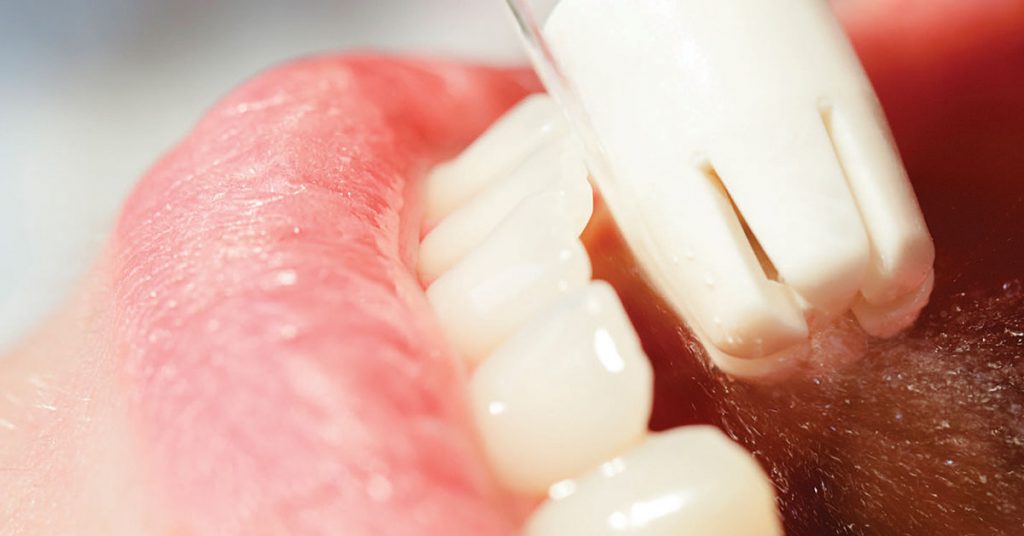Dental Water, Waterlines, and Recommendations

Dental unit waterlines are supposed to promote the development of biofilm (a coating of microorganisms) and bacterial growth, due to inconsistent flow rates, presence of long narrow-bore tubing, and also the potential for retraction of oral fluids. Waterlines on a delivery system is a complicated system. When dental water isn’t appropriately treated, dental health care patients and personnel might be placed at the risk of the adverse health effects.
Waterlines should be maintained regularly in order to deliver water of optimal microbiologic quality. Colonization of the microorganisms within the waterlines isn’t dangerous for healthy patients, but immunocompromised or older individuals are at risk. Even though infection because of the microbial contamination of the waterlines might be rather rare, it’s still an issue. Such microorganisms replicate and colonize on the waterline tubing interior surfaces, forming biofilms. These biofilms might be a reservoir, which amplifies many of the free-floating microorganisms in the water.
Dental Water Quality Improvement
It is recommended to use the dental water unit which measures ≤500 CFU/mL of heterotrophic water bacteria. There are several ways to improve dental water unit quality such as:
- Anti-retraction valves;
- Chemical treatments;
- Filtration;
- Utilize water sources that are separate from the public water system.
Microorganisms might come from the patients’ mouths during treatment or from the water sources. To limit this, you should flush the lines between the patients and install the anti-retraction valves. It is recommended to connect any devices which enter a patient’s mouth to the waterline and flush for at least twenty seconds between the patients. To add more, it is better to avoid warming dental unit water.
When you do surgical procedures, utilize only sterile solutions like irrigant or coolant utilizing a proper delivery device like sterile single-use devices, sterile tubing, or a sterile bulb syringe.
Tips for Dental Practitioners Concerning Dental Water:
- Implement the use of procedures and equipment like sterile water delivery systems, filtration systems, chemical treatment protocols, separate reservoirs.
- To guide dental personnel when it performs the infection control procedures for the dental unit waterlines, establish the written standard operating procedures.
- Purge the dental unit waterlines each night (it’s for units utilizing the separate water reservoirs). To prevent the stagnant dental water from settling within the waterlines, you should do it whenever the units are out of service.
- Monitor waterlines for visible contamination and damage and replace it if needed.
- Discharge air and water lines for a minimum of twenty-thirty seconds after each patient. Do it to physically flush out the patient material which may have entered the dental water system during the treatment.
- Remain alert to signs which might indicate the biofilm formation including particulates in the dental water, cloudiness, musty odor, and clogging of lines.
Don’t:
- Utilize the dental unit without following the disinfection and cleaning procedures in the manufacturer’s reprocessing guidelines.
- Attach dental instruments or dental handpieces to the dental unit waterlines which have not been disinfected or cleaned, according to the manufacturer’s instructions.
- Utilize disinfection and cleaning agents which aren’t recommended by the device manufacturer as long as material incompatibility might result in a structural damage which might increase the risk of toxicity and biofilm formation to patients.
Do:
- Utilize sterile irrigating solutions like saline and sterile water for surgical procedures. Use proper delivery devices to deliver sterile irrigating solutions during the surgery. It might include a dedicated surgical irrigation system and elements including handpieces which are single-use compatible and disposable with the heat sterilization methods utilized in the outpatient dental settings.
- Adhere to the manufacturer’s guidelines to disinfect and clean the dental unit at the recommended intervals. With any questions, concerning the reprocessing of the dental unit or to obtain the most up-to-date instructions, contact the manufacturer of the dental unit.
- Follow the recommended service maintenance and life of the dental operative unit with its accessories and components.
- Monitor the microbial contamination and dental water quality of the dental unit waterlines. Utilize standard culturing methods at the proper intervals in order to keep the bacterial counts lower than 500 CFU/mL of water.
- After disposable items are used, you should always properly dispose of them.
Recommendations for Dental Unit Water Quality
- Check your current reprocessing instructions in order to define whether your Instructions are appropriate, according to Section VI – “FDA’s Six Criteria for Reprocessing Instructions” of the FDA Guidance.
- Evaluate whether the additional validation testing is important to give modern comprehensive reprocessing instructions.
- Make sure your customers are aware of any available updated Instructions for Use.
- To determine if a new 510(k) submission might be important for any design or labeling changes, consult the FDA Guidance (“Deciding When to Submit a 510(k) for a Change to an Existing Device”).
- Make reprocessing validation test reports in the future dental operative unit 510(k)s. Describe the way reprocessing was considered in the device’s design.
Cleaning Dental Unit Waterlines
Check the recommendations about the way to clean your waterlines with your dental unit manufacturer. They might offer you options like the use of chemicals or filtration. Guidance may be different, depending on various factors. Make sure you are aware that a certain reagent is proper for your particular dental unit. As soon as you identify the proper process, you should establish a schedule for maintenance of the waterline.
Dental Water Quality Monitoring
To make sure a dental unit waterline cleaning regime is effective, test the water coming out of the unit. Some states like California and Washington, develop legislation which will make dental unit waterline testing required and is prescriptive. Inexpensive and simple products are available which estimate the number of bacteria in the dental unit water. Check your manufacturer to figure out a recommended schedule for monitoring their equipment.

